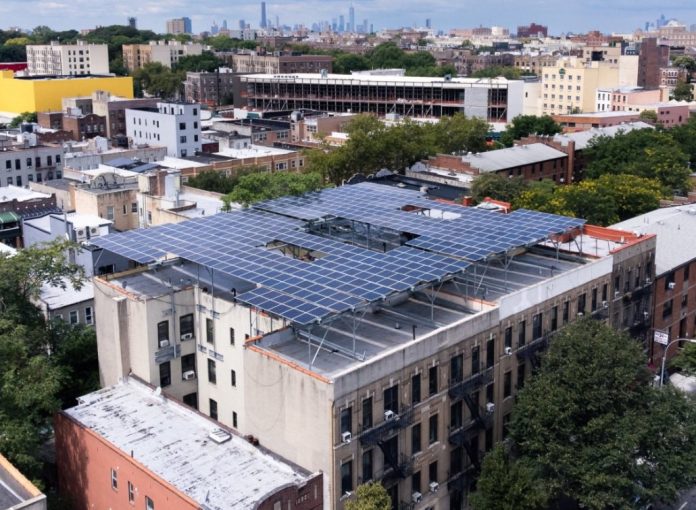At the ACORE Finance Forum, investors said a key challenge that statewide community solar programs do not yet address is how to unlock the opportunity of hundreds of thousands of building rooftops for solar development and bringing access to residents who rent their apartment.
With the Inflation Reduction Act providing solar projects built in designated energy communities a 10% investment tax credit adder, city and municipal authorities are focused on getting community solar projects installed on the roofs of urban housing authorities.
Speaking at the American Council on Renewable Energy (ACORE) Finance Forum in New York, Clark Conlisk, impact capital manager and vice president of business development, U.S. Bank, said a key challenge that statewide community solar programs do not yet address is how to unlock the opportunity of hundreds of thousands of rooftops for solar development.
To fully unlock the $20 billion or more in immediate energy communities incentivization under the IRA, “the challenge is now providing accessible clean power to renters who don’t have benefits that building owners might have for finding solar projects,” Conlisk said during an ACORE panel titled “Centering Equitable Investing Strategies.”
David Davenport, a managing director of the N.Y. Green Bank, echoed Conlisk’s observations, adding that the New York local project investment group recently unveiled a $250 million statewide fund, the Community Decarbonization Fund (CDF), to unlock new community solar and energy efficiency project opportunities around the Empire State for the $1 billion capital funded green bank.
“Normally residents did not want the smart sensors or controls products in their building when we came into housing authorities, they told us they have rodent problems first off,” said Davenport. Now with the IRA framework to incentivize disadvantaged communities, a collocated rooftop solar project that could drive 20% in monthly electricity savings is a topic that has been elevated in community discussions.
Lynn Heller, chief executive officer of the Climate Access Fund, a Maryland-based grassroots philanthropic and impact investor, said with the recent passing of Maryland’s community solar framework and adders from the IRA, her firm is spearheading the development of an 800 kW rooftop solar project in an East Baltimore, Md., low-income neighborhood.
In Maryland, Heller said the community solar market previously handicapped the low-to-moderate income community bracket, with 2 MW to 5 MW sized community solar projects historically being unavailable to LMI residents. Now her fund and statewide green banks are incentivizing housing authorities and urban authorities to look at rooftop solar as a beneficial tool for siting projects on urban rooftops and parking canopy arrays, as well, she said.
Davenport joked that with N.Y. Governor Kathy Hochul’s ambitious clean energy plan of deploying 10 GW of solar by 2030 and 6 GW of energy storage, the IRA incentives and the Green Bank’s new CDF fund, and the confluence of incentives and capital may require him to embark on a statewide bus tour to meet with constituents seeking to deploy solar, storage and efficiency projects.
The N.Y. Green Bank has a targeted allocation of investing about 35% of its $1 billion capital allocations into energy communities. The CDF platform encourages Community Development Financial Institutions (CDFIs) and other specialty lenders to apply for funding of disadvantaged communities across New York. Financing of $2 million to $25 million or approximately 20% of an applicant’s total capitalization are the parameters of the CDF fund.
In Maryland, Heller said community engagement and education is vital to rapid deployment of community solar projects over the next decade. Her group has been educating schools as well as former anti-hydraulic fracturing or fracking groups in western Maryland about the economic gains for deploying rooftop and various small-scale solar projects with various state and federal financial incentives.
U.S. Bank’s Conlisk admitted the perception of a commercial bank going into a disadvantaged community with a highly capital intensive project commitment hasn’t always been an easy proposition. But banks coming in early to demonstrate the gains of community-sited projects with an Impact Capital fund driven by municipal, state and federal incentives has begun to change misperceptions of clean energy projects.
Andrew Williams, vice president of policy and corporate affairs at developer Sol Systems, said “It comes back intentionality. We have to show up, say we’re going to hire people of the community, and to say that people from the community can operate the projects.”
“Paying prevailing wage is a non-issue,” Williams said. “That’s a mainstage item now. Showing up, being open about what your goals are in that community are essential,” Williams said about stimulating a local workforce and partnership level for community solar development.
Heller said that community solar subscriptions to the U.S. apartment rental market among the LMI community sub-set is an area that has been overlooked in IRA’s structure. Whether it be a consumer lease or building ownership model, that gap is what various statewide agencies such as CAF and various state green banks are now looking at changing.






